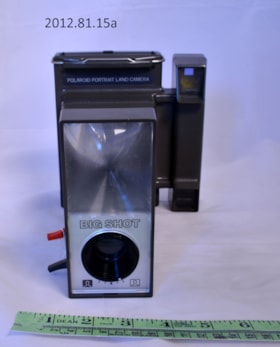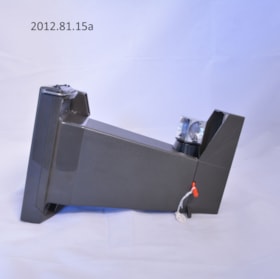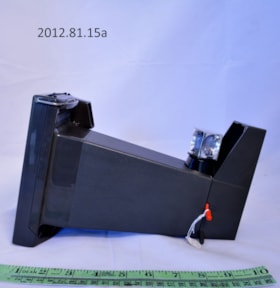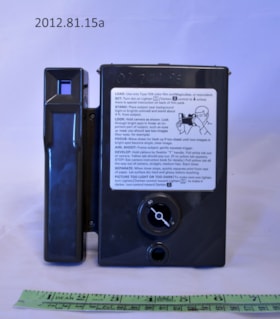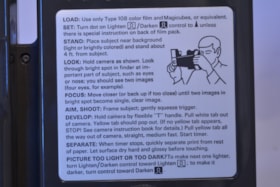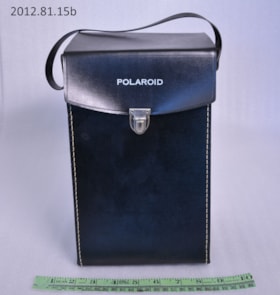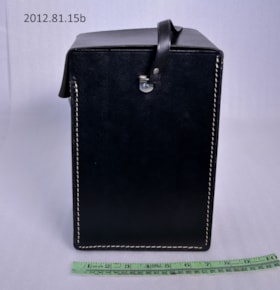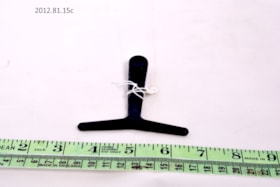Skip header and navigation
Camera and Case
- Description
- a) A "Big Shot" Polaroid Portrait Land Camera. A large grey camera with a body that starts wide and slowly narrows. Above the body on one end is a flash diffuser. Below this is "BIG SHOT" and the lens with a black dial around it to control light. On one side is a red lever. On the top is a clear cu…
- Category
- TOOLS AND EQUIPMENT FOR COMMUNICATION
- Sub-Category
- PHOTOGRAPHIC TOOLS AND EQUIPMENT
- Description
- a) A "Big Shot" Polaroid Portrait Land Camera. A large grey camera with a body that starts wide and slowly narrows. Above the body on one end is a flash diffuser. Below this is "BIG SHOT" and the lens with a black dial around it to control light. On one side is a red lever. On the top is a clear cube with "MAGICUBE SYLVANIA BLUE DOT" in black lettering surrounding a blue "X". On the wide section is the view finder and a white plate with instructions on it. Below this is a timer from 60 to 0. On the front of the wider section is "POLAROID PORTRAIT LAND CAMERA" in white lettering.
b) A rectangular black leather case with white lacing and a black plastic handle. The front flap attaches to to main body with a metal clasp. On the front flap in white lettering is "POLAROID".
c) A small T-shaped piece of plastic that attaches to the main body of the camera.
- Narrative
- A portrait camera. Released in 1971 and produced until 1973.
- History Of Use
- The Big Shot was one of the most unique cameras Polaroid ever introduced. It is a rigid-bodied model that dwarfs others in the series. Released in 1971 and produced until 1973, it was designed for portrait use only, and had a fixed focal distance of a few feet. It had a 220mm lens, a single-speed mechanical shutter, and a fixed-focus rangefinder to help the photographer keep the subject in focus. Above the body is a flash diffuser; it diffuses the light from the flash to soften shadows cast when taking the picture.
Because the camera itself is fixed-focus, the photographer has to move back and forth until the subject appears in focus. This technique has been called the "Big Shot Shuffle." The Big Shot also requires the use of MagiCube type flash cubes to take properly-exposed pictures and requires no batteries; the mechanical shutter is timed to interact with the flash cubes to (theoretically) provide the correct amount of light every time - though it also includes the Polaroid standard lighten/darken exposure controls around the lens. It should be loaded with ASA 75-100 Packfilms (100-series) to achieve good results. The camera's spreader bar, whose design freqently fouls (after repeated use) with debris, can be easily swapped out for the more advanced stainless steel roller assembly found in the Polaroid Colorpack series consumer cameras. Both the spreader bar assembly and stainless steel roller assembly are easily removed for cleaning of chemical residue. This same stainless steel roller bar assembly is also used in a lot of the commercial Polaroid cameras.
- Height
- b) 27
- Width
- b) 18.3
- Length
- b) 16.5
- Units Of Measurement
- Centimeters
- Accession No.
- 2012.81.15 a-c
- Type of Record
- Museum Artifact
Less detail
